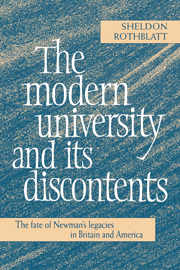Book contents
- Frontmatter
- Contents
- Preface
- 1 The idea of the idea of a university and its antithesis
- 2 ‘Consult the Genius of the Place’
- 3 ‘The first undergraduates, recognizable as such’
- 4 Failure
- 5 Historical and comparative remarks on the ‘federal principle’ in higher education
- Interlude: General introduction to Chapters six and seven
- 6 Supply and demand in the writing of university history since about 1790: 1. ‘The awkward interval’
- 7 Supply and demand in the writing of university history since about 1790: 2. The market and the University of London
- 8 Alternatives: 1. The importance of being unattached
- 9 Alternatives: 2. Born to have no rest
- Index
7 - Supply and demand in the writing of university history since about 1790: 2. The market and the University of London
Published online by Cambridge University Press: 02 December 2009
- Frontmatter
- Contents
- Preface
- 1 The idea of the idea of a university and its antithesis
- 2 ‘Consult the Genius of the Place’
- 3 ‘The first undergraduates, recognizable as such’
- 4 Failure
- 5 Historical and comparative remarks on the ‘federal principle’ in higher education
- Interlude: General introduction to Chapters six and seven
- 6 Supply and demand in the writing of university history since about 1790: 1. ‘The awkward interval’
- 7 Supply and demand in the writing of university history since about 1790: 2. The market and the University of London
- 8 Alternatives: 1. The importance of being unattached
- 9 Alternatives: 2. Born to have no rest
- Index
Summary
A METROPOLITAN PESTHOUSE
The history of the invisible hand of the market in relation to English universities is also illuminated by analysing the foundations and subsequent evolution of the University of London and its colleges.
Three particular themes or threads run through the course of the following discussion. The first is the relationship of the London University to its specific urban environment at the time of its founding, meaning the relationship of the university to an actual or potential local market for students, resources and services. The second is its relationship to other preexisting educational institutions against which, inevitably, it was compared and measured. And the third is the position of the new university with respect to certain special features of Britain's urban and national cultural history.
Conceived in 1826, the London University was only the third university to be created in England, although smaller Scotland had five, two of which, Marischal and King's College, were university colleges later united as Aberdeen University in the middle of the nineteenth century. London was not established as a rival to Oxford and Cambridge, whose curriculum and socially exclusive intake had long been under attack, but as a university serving a different market. It could not be convincingly argued that London's establishment was necessary because of the decline of Oxford and Cambridge. The fortunes of the ancient universities were actually on the rise at the time of London's founding.
- Type
- Chapter
- Information
- The Modern University and its DiscontentsThe Fate of Newman's Legacies in Britain and America, pp. 349 - 385Publisher: Cambridge University PressPrint publication year: 1997



